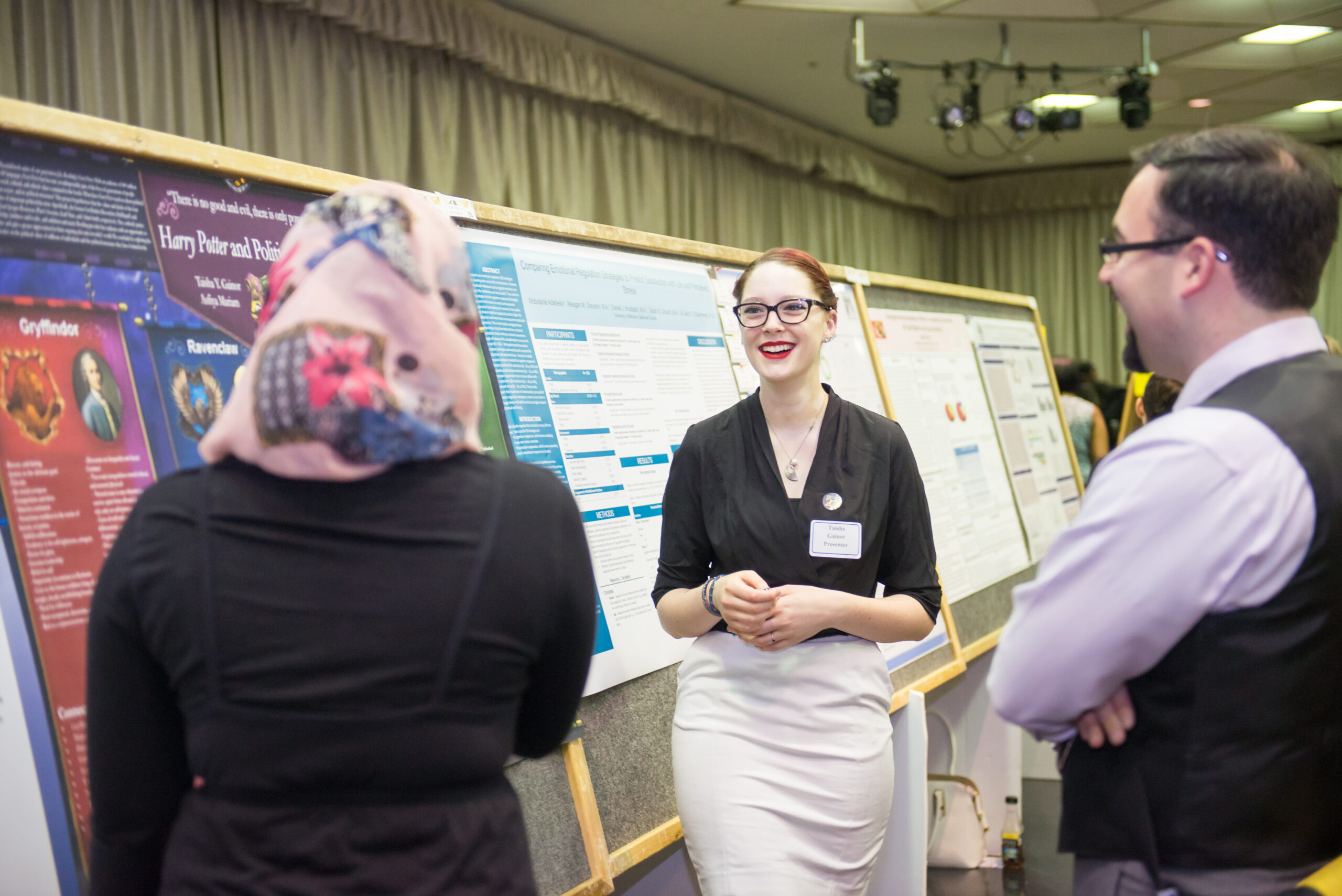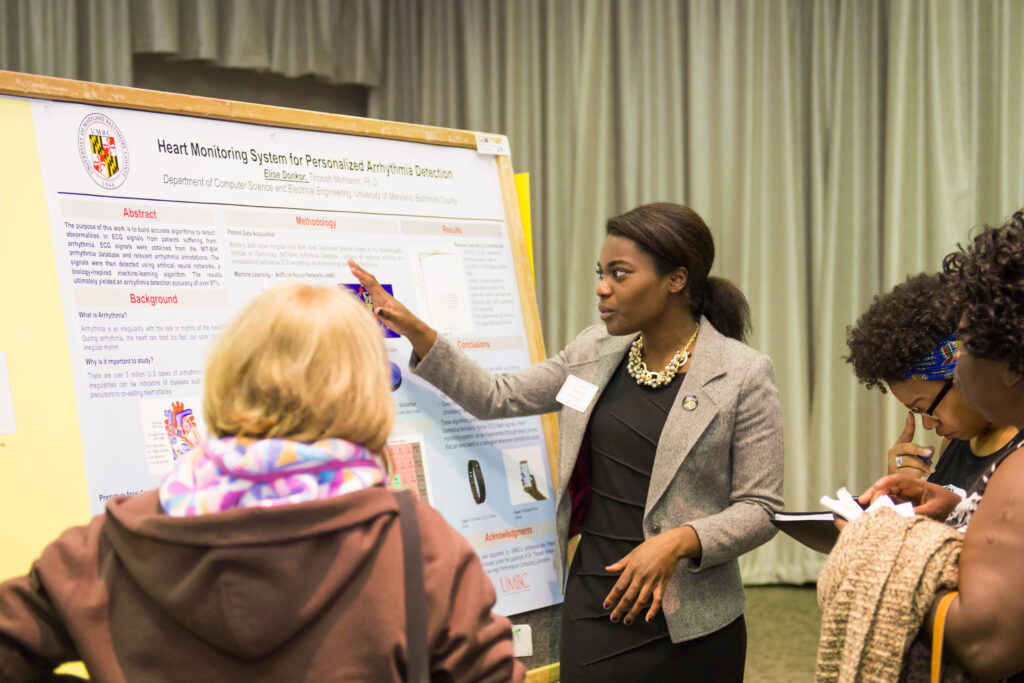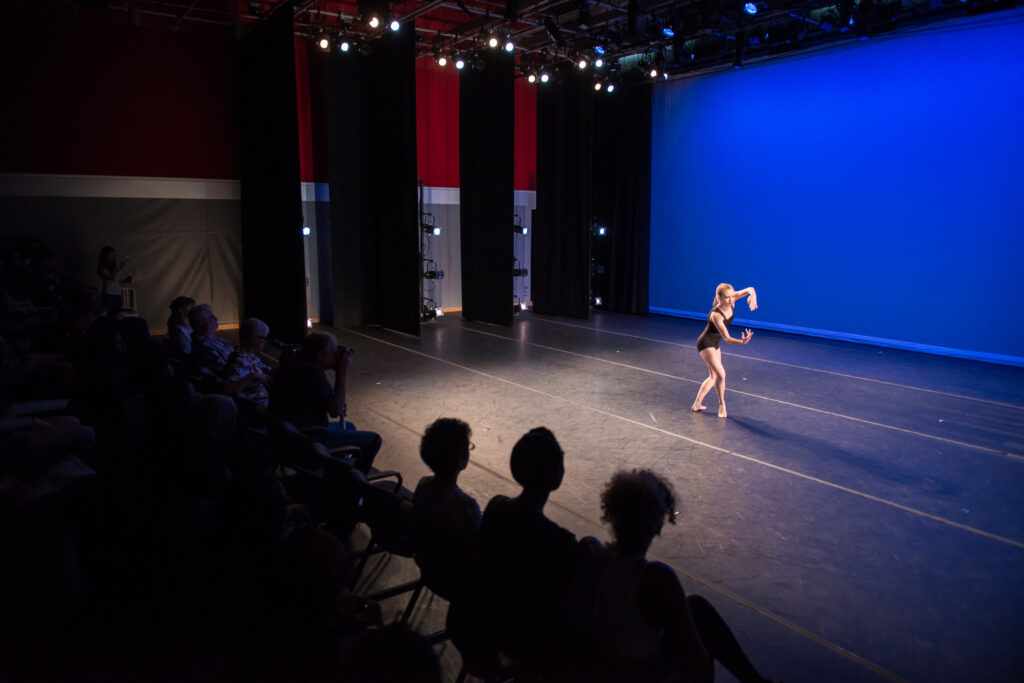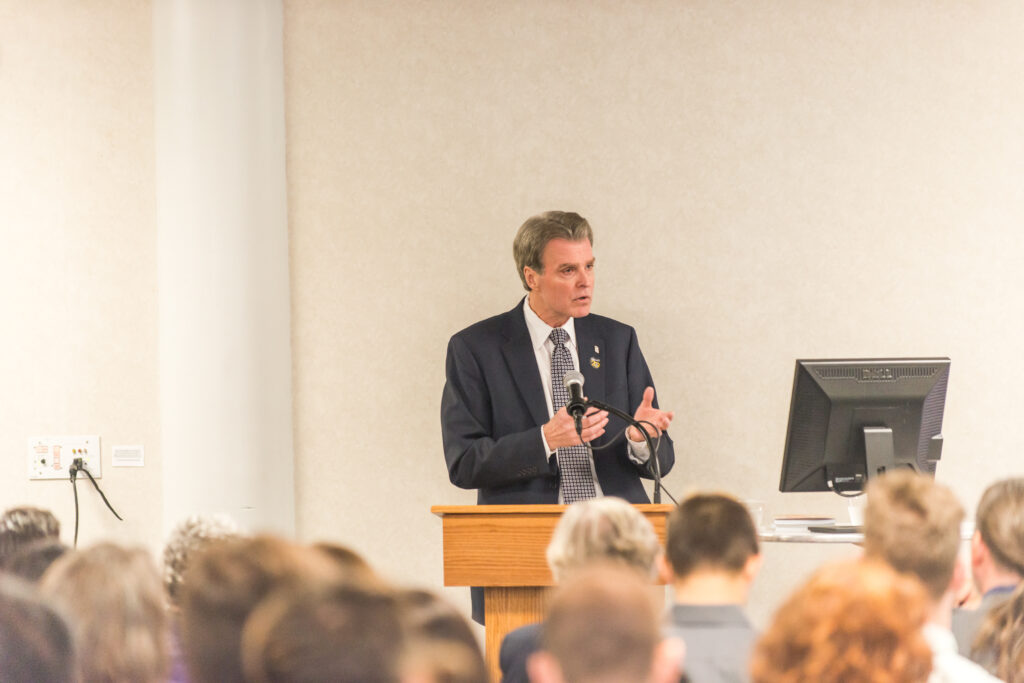The University Center Ballroom was humming on Wednesday, April 27, with the voices of hundreds of UMBC students presenting their research and creative work to proud long-time supporters and curious first-time visitors alike.
This year UMBC celebrated its 20th annual Undergraduate Research and Creative Achievement Day, a particularly special celebration for a university so focused on student-led projects and engaged learning experiences. As Diane Lee, dean of undergraduate education, said, reflecting on the anniversary, “Indeed, we know of no other university where so many students, faculty members, and staff gather to come and learn from the voices of undergraduate students.”
URCAD programming included performances, film screenings, exhibits, posters, and talks from all disciplines, as well as a large number of interdisciplinary partnerships.
Aakash Bajpai ‘18, mechanical engineering, and three partners presented a collaboration with the Baltimore City Department of Public Works on research to anticipate when aging city pipes will fail before those incidents occur. Their research is also helping to determine why these pipes are failing and how the failures can be prevented in the future. Bajpai says that this project can save Baltimore millions of dollars by minimizing the disruptions caused by emergency repairs, moving toward a more proactive and cost-effective infrastructure maintenance approach.
Joel Tyson ‘18, biochemical engineering, is studying probes to determine whether they are compatible with the chemistry of the human body, under the mentorship of Gymama Slaughter, assistant professor of computer science and electrical engineering. The probes will be used to simultaneously sense neurotransmitters and monitor the electrical activity in the brain. Analyzing the safety of the probes and how they interact with the body’s chemical composition will be essential for when the probes are tested on mice and, later, in human models. The sensor is being designed as a more effective, less invasive way to continuously monitor neurotransmitter release and the brain’s electrical activity in people with neurological disorders.
Elise Donkor ‘16, computer engineering, is developing more personalized software to better diagnose and treat patients experiencing heart arrhythmia. Unusual patterns in heart activity can be signs of conditions like diabetes or heart attacks. Current software designed to track heart activity is mass produced, Donkor explains, and personalization could make it a more effective tool. The algorithms that she has developed to detect abnormalities have shown a 97.8% level of accuracy in identifying arrhythmia patterns.
Nerissa Vasconcells ’16, dance, presented her solo dance performance Limitless. Her primary research focuses on modern dance and methods developed by such masters as Graham, Horton, and Limon, but Vasconcells also has studied ballet. She was motivated to create a work that “emphasized beauty as a classical ballet choreographer, while using choreographic methods commonly found in modern dance.” Vasconcells says, “classical ballet has its origins in the 18th and 19th centuries, emphasizing elegance, beauty, and regimentation, and has a choreographic process directly related to a musical score. Modern dance, a product of the 20th century, is often abstract and uses a wide variety of choreographic processes not linked to the musical score. Combining these varied techniques has been a personal challenge and a pursuit of self-exploration.”
Rachel Wolven ’16, visual arts, presented her time-lapse photography film, Light Inhibits Light, the culmination of a comparative study of the visibility of deep space objects and the Milky Way as affected by light pollution. Her film presented over a dozen night sky locations from Baltimore to Nova Scotia, with light pollution measurements and GPS coordinates noted to orient viewers. Her time-lapse photography captured sublime celestial movements across dark skies as well as starless, hazy summer city nights, highlighting both particle and light pollution. Wolven aims to “bring attention…to show what is missing from the skies above our cities.” She says, “To protect this natural resource, awareness must first be raised in order for people to want to make changes and work to fight the overabundance of light pollution.”
James Loy ’16, mathematics and physics, works with Matthew Pelton, assistant professor of physics, on “quantum dots,” which are nanoscale semiconductor crystals. The dots may eventually be used as a lower-cost alternative to silicon-based solar cells. Using “acceptor molecules” to grab the excited electrons released by the dots increases overall electrical current output. Loy’s work showed that more acceptor molecules increased the output linearly, which is encouraging for future work to optimize quantum dots for eventual commercial use in solar energy harvesting. “Working in Dr. Pelton’s lab was the best part of my college career,” Loy says, noting “I experienced research from the posing of the problem through to publication.” Loy will pursue a Ph.D. in physics at Princeton this fall.
Rebekah Rashford ’18, biological sciences, is studying how ribosomes, the cellular structures that build proteins, are put together. Ribosomes are made of both protein and RNA. The unnecessary parts of the initial RNA molecule need to be cut out before it can function in the ribosome, a process called “maturation.” Ribosomal proteins bind to the RNA throughout the maturation process. By taking snapshots of the RNA at different points in time, she’s creating a map of what happens when. This foundational research could eventually contribute to treating diseases caused by ribosomal defects. Rashford’s mentor, Lasse Lindahl, professor of biological sciences, has had a major impact on her UMBC experience and aspirations as a scientist. “He’s so excited about the research, and he gets me excited about it, too.” Rashford says. “When you’re motivated, your work will be that much better.”
Taisha Gainor ‘16, political science, and Asfiya Mariam ’16, biological sciences, researched how pop culture can influence citizens’ participation in politics. After coming across studies suggesting people who have read or watched Harry Potter are statistically more likely to participate in politics, they focused on exploring the series’ political elements. Gainor noted that she hopes her work will spur more engagement with the political system. “I think it’s a great way to get people involved in politics…relating it to something that they want to talk about and then showing how that actually relates to things in their everyday life.”
Deirdre Lohrmann ‘16, ancient studies and history, studied Roman glass production in antiquity with a specific focus on glassware from the Marie Spiro collection. Viewing a display during UMBC’s Ancient Studies Week sparked her interest in the project, and she says that studying artifacts from Ancient Rome has helped her develop a greater appreciation and understanding of the world around her. “We learn from our past,” she says, to understand the similarities between people in antiquity and people today.
Throughout the event, students shared the impact of mentors who served as guides through research and creative processes and as sounding boards on graduate school and career path possibilities inspired by their work.
Featured URCAD speaker Mark Reynolds ‘78, ‘82 M.A., psychology, picked up on these themes. Reynolds, now dean of the University of Maryland School of Dentistry, shared how his undergraduate research experience paved the way for his career and how UMBC faculty mentors helped him develop a passion for teaching, learning, and supporting others.
“To students, please give back,” said Reynolds crediting his career success to the interest and mentorship of people who encouraged him during his student years. “It is so important,” he told the URCAD crowd, “…and you want to perpetuate that.”
Visit the URCAD website to access the full list of student presenters.
**Update: Dean Scott Casper and Provost Diane Lee invite the university community to a campus forum on Thursday, May 12, at noon in the Albin O. Kuhn Library and Gallery, where students Zoe Wang and Riley Auer will present their poster, “Illustrating the Unseen: Analogy and Metaphor in an Ancient Gynecological Text.” This event follows a decision made to move the poster before URCAD began and a thoughtful conversation that followed, regarding the important issues of the nature of artistic, humanistic, and scientific research and representation; the presentation of research to academic and public audiences; and the meaning and centrality of academic freedom. In addition to the presenting students, several members of UMBC’s faculty, including Carole McCann, Preminda Jacob, Molly Jones-Lewis, and Stephen Freeland, will reflect on the issues that the poster and its presentation raise for scholarship and our academic community, and audience members will be welcomed to join in the dialogue.
Images: URCAD 2016 posters, performances, and presentations by (from top to bottom) Taisha Gainor ’16, political science; Elise Donkor ’16, computer engineering; Nerissa Vasconcells ’16, dance; and Mark Reynolds ’78, ’82 M.A., psychology. All photos by Marlayna Demond ’11 for UMBC.
Tags: AncientStudies, Biology, CAHSS, CNMS, COEIT, CSEE, Dance, History, MathStat, MechE, Physics, PoliticalScience, Undergraduate Research, VisualArts







